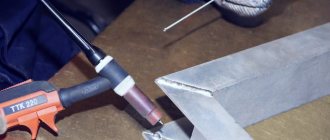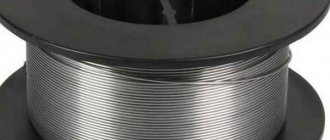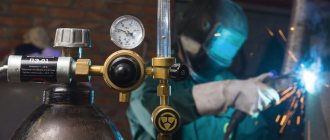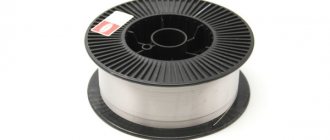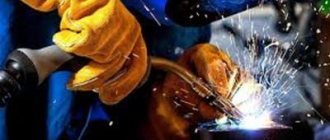Theoretical part:
- Construction of a semi-automatic welding machine
- Choosing gas for semi-automatic welding
- Wire for semi-automatic welding
- Semi-automatic welding without gas (with flux-cored wire)
Practical part:
- Preparing the device for operation - ASSEMBLY | How to thread wire into a semi-automatic machine
- Setting up a semi-automatic welding machine using a live example
- Preparatory stage and process of welding with a machine
- Direction and speed of movement for a perfect weld seam
- Conclusion + VIDEO
Despite the opportunity to jump straight to practical advice, we recommend that you read the material in its entirety. You will probably find something new for yourself or refresh your previously acquired knowledge.
Semi-automatic welding machine - briefly about the device
Semi-automatic welding requires a basic understanding of the design of the welding machine. The inverter provides space for installing a coil of wire, which serves as an analogue of a consumable electrode, and also has an automatic feed mechanism. The device allows you to independently set the current strength and wire feed speed depending on production needs.
Semi-automatic devices vary in functionality depending on their purpose. For novice welders, the best choice would be reliable and easy-to-operate devices without excesses (for example, IRMIG 160) or options with synergetic control, which will greatly facilitate setup (for example, INMIG 200 SYN). For experienced professionals, powerful three-phase semi-automatic machines, such as the INMIG 500 DW SYN, are suitable for continuous production.
Regardless of the type of device, the operating equipment remains standard:
- Welding machine
- Semi-automatic welding torch
- Gas cylinder and reducer
- Gas hose
- Cable with ground clamp
Of course, the work will require specialized wire, as well as standard protective equipment that is absolutely necessary for the safety of the welder.
The choice of gas depending on the metal being welded
The main function of shielding gas is to isolate the weld pool, electrode and arc from the influence of ambient air. In order to select the appropriate gas, it is necessary to take into account the type of material and its thickness. Depending on this, inert, active gases or mixtures thereof are selected. The most commonly used are CO2 and argon. The latter reduces metal spatter and contributes to better weld quality.
Pay attention to the table:
| Material | Gas |
| Structural steel | CO2 |
| Structural steel | CO2 + Ar |
| Stainless steel | CO2 + Ar |
| Alloy steels (low carbon) | CO2 + Ar |
| Aluminum and its alloys | Ar |
HELPFUL ADVICE.
When searching for gas, you can come across cylinders of various sizes. The larger the volume, the cheaper a liter of gas will be. For rare use of a semiautomatic welding machine, mobile packaging of 5-10 liters is suitable. In this case, it is best to take an additional supply of gas to insure against a sudden shortage.
Relationship between metal thickness and wire diameter
There are many wire options for semi-automatic welding on the welding materials market. It is important to remember the rule - the composition of the wire must match the composition of the material being welded. The welding wire SV08G2S, which is used for carbon and low-carbon steels, is most often in demand.
The table will help you choose the diameter:
| Metal thickness, mm | The diameter of the wire |
| 1 — 3 | 0,8 |
| 4 — 5 | 1,0 |
| 6 — 8 | 1,2 |
The usual packaging for wire is 200 or 300 mm.
IMPORTANT!
The wire diameter is indicated when setting up the semi-automatic machine, which we will talk about in the practical part of this article.
How to weld semi-automatically without gas
Shielding gas is essential to the welding process. It ensures quality welding work while creating a protected environment. However, if you use the device quite rarely, then it is simply not profitable to spend too much money and buy a cylinder. To avoid unnecessary costs, you can always use a special welding wire - flux-cored or flux-cored. It consists of a steel tube containing flux inside. During welding, it burns, forming a cloud of shielding gas in the welding zone.
It is worth remembering that work with flux-cored wire must be carried out with a current of straight polarity (plus is supplied to the product) - this is due to the need for more power to melt the flux-cored wire. It is worth paying attention to the fact that in addition to the obvious advantages of use, there are also disadvantages: when welding with flux-cored wire, a cloud of smoke is usually formed, which complicates visual control of the process. It cannot be used for ceiling seams.
What do you need to know about semi-automatic welding?
Before you learn how to properly weld with carbon dioxide using a semi-automatic machine, you need to understand the technology itself in more detail.
The welding process using this equipment is quite simple. The wire is fed continuously at a certain speed, and carbon dioxide or another gas mixture enters the working area through the nozzle. Such units are very easy to use and allow even non-professionals to carry out work, which is why they are very popular in everyday life and in small private enterprises.
One of the main advantages of this technology is the ability to work with both thin products (up to 0.5 mm) and large thicknesses. In addition, the total cost of the work is relatively small.
A semi-automatic welding machine is a mechanical device in which a coil of wire is installed, acting as a consumable electrode, and a mechanism for automatically feeding it. The current strength and electrode feed speed are set by the welder on the machine himself, depending on the type of metal that is being fused and the speed of movement of the torch.
There are many different units for welding work. To organize them a little, there are several classifications. Let's consider the most basic one - the method of protecting the material during the process:
- semi-automatic welding under a layer of flux (flux is a powdery composition that is located in the middle of the working wire. In its chemical properties, it resembles electrode coating);
- welding in inert and active gases;
In addition, there are single-phase and three-phase units for semi-automatic welding. Single-phase models operate from a regular 220V outlet. In this case, if the network does not match the power of the unit, the arc will not be stable, which will lead to defects when creating a seam. A three-phase device cannot be connected everywhere, but at the same time it is distinguished by high quality of work under different loads.
Although the listed semi-automatic welding machines differ from each other, they all have the following equipment:
- current source;
- gearbox for moving the electrode;
- burner;
- welding cable with clamp;
- control system;
- gas cylinder;
- gas supply hose.
Gas welding - a universal solution
It is difficult to find an industry where gas welding is used - a method of firmly joining metals to each other in the melting stage with a flame of special temperatures. After all, acetylene burns at 3,200-3,400 degrees.
Gas welding technology is simple. This method can replace electric arc, but gas cannot. But still, the first one has priority on thin metals. The arc will simply melt them, as in open-hearth, and not hold them together.
SEMI-AUTOMATIC WELDING TECHNIQUE
Let's look at how to weld semi-automatically, since this type of work has several options - welding with shielding gases and welding without gas, using flux-cored wire.
SEMI-AUTOMATIC WELDING TECHNOLOGY IN A SHIELDED GAS ENVIRONMENT
For semi-automatic welding, you can use several types of gases. The most commonly used gases are carbon dioxide or helium. This is due to their availability and low cost of use. Gases are used to reduce oxidation of the metal from which the part being welded is made, in order to increase the strength of the weld. The main condition for operating a semi-automatic machine with carbon dioxide is preliminary preparation of the part. This means thoroughly cleaning it to remove all dust, dirt, paint residue or rust. To do this, use sandpaper or an iron brush.
There are three types of welding technology:
- continuous welding, when a torch or non-consumable electrode is carried out from the beginning to the end of the seam;
- spot welding, in which parts are connected not by a continuous path, but by welded spots;
- Short circuit welding is carried out mainly for thin sheet metal and involves melting the metal by applying pulses from a short circuit that forms in the welding machine. Once closed, the molten material is pulled together into a droplet, which is used to join the two parts.
Most often, semi-automatic welding with carbon dioxide is performed in alternating current mode. Before starting work, you need to prepare everything for welding. The device is adjusted depending on the type of metal and its thickness. The gas consumption from the cylinders will depend on the welding mode. The wire diverges almost equally - on average 4 centimeters per second. More precise settings can be found in the GOST tables, which indicate the modes and standards for each type of metal. When both the equipment and parts are ready, you can begin connecting the products using a semi-automatic machine. First of all, you need to turn on the gas supply and then excite the arc. To do this, you need to touch the part with the wire. When you press “start/start” on the body of the device, the mechanical feeding of the electrode wire begins.
The quality of the seam depends on many nuances. For example, it is important to hold the wire and guide it straight, but not too close to the workpiece. So as not to block your view of the weld pool. During work, it is important that the required interval is maintained between the edges of the parts being welded. The operating technology is such that when the product is up to a centimeter thick, the gap should be no more than 1 mm; when the product is more than a centimeter thick, the gap is 10% of this value. Very often, parts in a lying state are welded on a special iron substrate, placing it from below very tightly to the base metal.
Electric welding training
Connecting the electrode and striking the arc
The electric welding process for beginners and experienced welders begins with connecting the electrode and igniting the arc. It is more convenient to start welding lessons with universal electrodes with a diameter of 3.2 mm. Such electrodes have a higher price, but they greatly facilitate the welder’s work.
A clamp is placed on one of the cables of the welding machine; as a rule, they are of two types:
- Screw. The holder handle rotates and allows you to insert an electrode into the resulting socket;
- Spring-loaded. To insert the electrode, you need to press the button on the handle.
After connecting the electrode, it is time to connect the device cables. The welding unit has two outputs: negative and positive and two cables:
- The first ends with an electrode clamp;
- The second has a lock for connecting to the part.
The connection diagram depends on the operation. In inverter devices, the plus is connected to the part, and the minus to the electrode. This polarity gives better heating of the metal and, consequently, greater strength to the welded joints. To weld stainless steel with argon, a reverse connection is made.
After connecting the electrode and cables, you need to learn how to strike an arc. Its ignition occurs when the part and the electrode come into contact. Two methods are possible:
- Tapping. It is necessary to lightly hit the part with the end of the electrode several times;
- Carrying out. A rapid conductive movement of the electrode is made along the future seam.
The new electrode ignites quickly. It is a little more difficult to ignite an already used one - to do this, you need to free it from carbon deposits by tapping it on the part.
Before proceeding to the next stage of training, you need to learn how to stably and quickly ignite an arc.
Practicing tilting and moving the electrode
The most convenient position of the electrode is characterized as inclined towards the welder at an angle of 30-60°. Variation in these proportions is carried out during welding according to the state of the weld pool.
There are two options for tilting the electrode:
- Angle back . According to this scheme, the molten slag follows the electrode, which moves at such a speed that the slag has time to cover the weld pool. With this position of the electrode, the metal is heated to a considerable depth;
- Forward angle . In this case, the heating of the metal will not be strong, the weld will follow the electrode.
When welding, the master must evaluate several parameters:
- The movement of the electrode must be carried out according to a planned pattern to obtain an even and beautiful seam;
- As the metal melts, the electrode moves lower, but not more than 2-3 mm from the edge of the metal;
- The condition and size of the weld pool are controlled by the speed of the electrode;
- It is important to control the direction of the seam.
First stage of training: rollers
You must begin your training in the basics of electric welding with beads - welding seams on thick pieces of metal, where the skills of using an electric arc and welding seams are practiced.
The sequence for creating rollers is as follows:
- For testing, a thick sheet of metal is taken, cleaned of rust and dirt;
- All manipulations with the welding machine and arc are carried out in a suit and with eye glasses!
- After ignition, the arc is brought to the metal at a distance in the range of 3-5 mm. It is important to ensure that the distance between the workpiece and the arc is the same; this is the key to an even and uniform seam. The electrode is held at an angle;
- It is important to understand whether the current supplied by the welding machine is sufficient. If the arc goes out, then the voltage must be added. If the voltage is too high, the arc will not melt, but cut the metal;
- Let's consider the structure of the metal in contact with the arc. It is important to understand where the weld pool is formed during welding and monitor it. This area of molten metal will appear whitish in color with characteristic ripples of liquid metal on the surface;
- When a weld pool appears under the ignited arc, you can begin to make a seam by moving the electrode. The bath will follow the arc, and the pressure of the arc will force the bath to also move in the opposite direction, resulting in a roller;
- When creating rollers, it is necessary to adhere to certain patterns of movement of the electrode - these can be translational movements with a small and always equal amplitude to create an even and beautiful seam.
Welded joints
Do-it-yourself electric welding involves creating welded joints. You can start practicing them after mastering rollers. This requires practical skill in using a welding machine, which is why it is so important to practice your movements on workpieces before moving on to welding elements.
It is recommended to start welding joints of metal elements on small workpieces. The sequence of work is as follows:
- Before welding, the parts are fastened in the required position using auxiliary tools;
- First of all, tacks are made - spot seams in increments of 8-10 cm, which fasten metal elements in certain places. This is necessary in order to give the workpiece a certain strength and the metal does not warp when making a long seam. Making such tacks also makes it much easier to create the main long seam. As a rule, tacks are made on both sides of the part;
- After the tacks are completed, a common seam is created that welds the edges of the two metal elements. Here it is important to move the electric arc with sufficient amplitude, raking the molten metal into the weld pool from both planes to be welded.
After cooling, the seam is hammered off the slag and checked for quality. If there are defects or uncooked areas, they must be brewed again.
Semi-automatic welding: possible adjustments during the process
In order for the seam to turn out smooth and beautiful, you need to feel the semi-automatic machine and be able to adjust it correctly. It is necessary to set the necessary parameters according to the setting tables that are attached to the technical documentation for the device of a particular type. You cannot cook at a low operating current: this will affect the quality of the seam, and in some cases it will not even be possible to connect the parts together. The following principle is observed: the thicker the metal, the higher the operating current or voltage (depending on the operating principle of the semiautomatic device).
How to cook semi-automatic video lessons:
WELDING OF ALUMINUM SEMI-AUTOMATIC
A semi-automatic machine can be used to weld various metals, and aluminum is no exception. But there are special rules, since this metal has some special features. On its surface there is a thin layer of amalgam, whose melting point is much higher than that of aluminum (more than 2000 degrees, while the base metal melts at 650 degrees). In this case, argon is used as an inert gas. Since aluminum quickly melts and begins to flow, a substrate is used to work on a semi-automatic welding machine.
The welding process itself occurs with consumable electrodes under the influence of direct current of reverse polarity - this is when a negative charge is attached to the part, and a positive charge to the torch. Such welding techniques contribute to high-quality melting of the workpiece and rapid destruction of the top layer. Although for such a connection you can use another trick - pre-clean the product to remove the oxide film. You can read more about the features of working with aluminum here.
The joining technique can be performed in different spatial positions using different types of seams.
Advantages and disadvantages
The advantages of gas welding include:
- low price of equipment;
- possibility of welding and cutting in field conditions;
- regulation of flame power over a wide range;
- welding of most types of metal and alloys - from aluminum to alloy steels;
- smooth heating, preventing the deformation of parts and the formation of cracks.
Flaws:
- Low efficiency due to high heat dissipation. For the same reason, the technology is not cost-effective when welding workpieces thicker than 5 mm due to excessive gas consumption.
- Heating a large area of areas adjacent to the seam contributes to the formation of residual stresses in the metal.
- When joining with an overlap, there is a high probability of deformation of the parts.
- Due to the peculiarities of the operating principle, the gas welding process is difficult to mechanize.
- The use of flammable gases is associated with a high explosion and fire hazard.
Semi-automatic welding of stainless steel
There are several key features that you need to be aware of if you want to form a quality seam. We will list the most important of them.
As we said above, pure argon or pure carbon dioxide is rarely used for welding stainless steel. It is better to use a gas mixture. It should consist of 70% carbon dioxide and 30% argon.
Semi-automatic stainless steel welding
Also pay attention to the protrusion of the filler wire relative to the torch. The optimal length of the visible part of the filler material is from 6 to 12 millimeters. When forming a seam, monitor the distance from the nozzle to the metal surface. The smaller it is, the better. It is not easy, but with frequent practice you can achieve good results. Don't skimp on gas. If there is not enough gas, the seam will be of poor quality.
We recommend setting the polarity reversed. Direct polarity is used only when using fluxes, which is not provided for in the technology we describe.
The welding angle is also important. The optimal value is from 5 to 10 degrees relative to the part. This way the seam melts well and turns out smooth. This is especially important when welding thick parts, where it is necessary to thoroughly melt the metal.
SEMI-AUTOMATIC WELDING WITH WIRE
The peculiarities of welding are that work can be done both in a gas environment and without the use of carbon dioxide, helium or argon. One popular joining method is submerged arc welding. It is more often used in industrial conditions than in domestic ones. This is due to the fact that flux itself is an expensive material. This is the powder that is found in the middle of the wire. During melting, under the influence of high temperature, it releases a gas cloud that protects the weld pool from oxidation. That is, in this case, additional inert gas is not supplied from the cylinder.
The main advantage of flux-cored wire is that it can be used to weld with a welding machine outdoors or indoors in a draft. For example, when gas welding, you will not get a high-quality path if there is wind, since it violates the gas flow.
How to cook semi-automatically without gas?
Semi-automatic welding without gas can be carried out under any conditions, both indoors and outdoors.
It is not recommended to weld too thin sheets or medium-carbon steel with a welding unit using self-shielding wire, as defects may appear (mainly hot cracks).
To increase the temperature of the welding arc to quickly and efficiently melt the flux, you need to use the same trick as with aluminum welding - apply reverse polarity.
Equipment used
The set of equipment for gas welding includes:
- Water seal to prevent damage to equipment components from backfire. Installed between the burner and the acetylene source. As evaporation occurs, water is added.
- Oxygen and flammable gas cylinders or acetylene generator. According to safety regulations, the gas should not come into contact with the paint. Therefore, the top of the cylinders is not painted. To prevent an explosion when acetylene comes into contact with copper, valves made of a different metal must be installed on cylinders with this gas.
- Gas burner, regular or injection.
- Reducers to reduce the pressure of gas and oxygen at the outlet of the cylinders.
- Hoses for connecting the gas burner to cylinders. Hoses for flammable gases have a yellow stripe.
Gas welding equipment
If gas welding work is carried out in different places, the equipment is installed on a trolley with appropriate fastenings. Enterprises install stationary gas stations with ventilation and cabinets for storing cylinders.
BASIC RULES FOR WELDING WORK
To become a real professional, you need to know everything about semi-automatic welding, and safety is one of the important aspects. It is necessary to study and every time comply with all the norms and standards prescribed in GOST. Safety precautions must not be neglected when working with fire and gas cylinders. It is also important to protect yourself by wearing a uniform and a mask that will protect your eyes from UV burn.
Not only beginners, but also experienced craftsmen are recommended to initially try the seam on a rough part or on an inconspicuous area to make sure that the settings on the semi-automatic welding machine are correct. Before using the unit, you must read the instructions and follow them during operation. And yet, the device cannot work continuously. That is, you need to pause periodically; this is written in the instructions for them.
Automatic and semi-automatic welding requires a long training process, which includes theoretical and practical knowledge. Training to become a welder is a long and responsible job, although once you understand everything, you can understand that it is not difficult if you follow all the recommendations.
And in the end, I would like to answer one of the most frequently asked questions, what is the difference between automatic welding and semi-automatic welding:
- automatic welding is a process in which the movement of the arc and the supply of the electrode are mechanized;
- semi-automatic welding is a type of welding in which the wire is fed mechanically and the arc is moved manually.
How to cook semi-automatically video:



